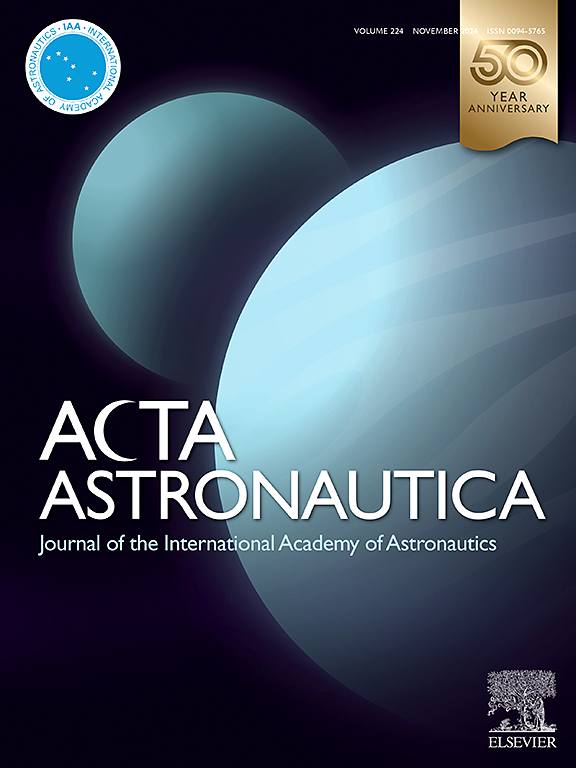提出一种新的月球风化层模拟物类别:在地球重力下表现出与月球重力下的天然风化层相当的自重的减少颗粒密度模拟物
IF 3.1
2区 物理与天体物理
Q1 ENGINEERING, AEROSPACE
引用次数: 0
摘要
目前在地球重力中使用的“正常密度”月球风化层模拟可以被视为对月球重力中月球风化层散装物质处理行为的拙劣复制。地球上这种正常模拟物的自重是月球的六倍,这可以被视为潜在的原因。作为开发月球用途技术的一部分,在地球重力中使用这种正常模拟可能无法充分预测月球的行为,并导致次优结果。本文提出了一类新的减少自重的月球风化模拟物,以尽量减少这一问题。目前的工作详细阐述了这种新型月球风化层模拟物的情况,其颗粒密度降低了原生月球风化层的六分之一,从而减少了自重。为了进一步证明这种方法的合理性,报告了一系列研究,以突出当前和拟议的模拟使用之间的预期差异。首先,利用基于Jenike理论和Bond Number概念的分析论证来突出预期差异。其次,采用离散元法模拟显示了两个模拟类之间的预期行为差异。第三,使用实验室面包板卸料斗来演示正常和减轻自重兴奋剂之间的行为差异。此外,还提出了此类减轻自重的模拟物的要求清单。这项工作的结论是,提议的新一类降低粒子密度的月球模拟物似乎有价值,应该由相关社区进一步研究。本文章由计算机程序翻译,如有差异,请以英文原文为准。
Proposal of a new category of lunar regolith simulants: Reduced particle-density simulants that exhibit equivalent self-weight in Earth gravity to native regolith in lunar gravity
Current “normal density” lunar regolith simulants used in Earth gravity can be viewed as a poor replication of bulk material handling behaviour of lunar regolith in lunar gravity. The six-times greater self-weight of such normal simulants on Earth compared to the Moon can be the viewed as the underlying cause. The use of such normal simulants in Earth gravity as part of technology development for lunar use may fail to adequately predict lunar behaviour and result in sub-optimal outcomes. This paper proposes a new class of reduced self-weight lunar regolith simulants to minimise this issue.
The current work elaborates the case for this new class of lunar regolith simulants with reduced particle density of one-sixth native lunar regolith resulting in reduced self-weight. To justify further this approach a series of studies are reported to highlight the expected differences between the current and proposed simulant uses. First, analytical arguments are used based around Jenike theory and the concept of Bond Number to highlight expected differences. Second, Discrete Element Method simulation is used show the expected difference in behaviour between the two simulants classes. Third, a laboratory breadboarded discharge hopper is used to demonstrate behaviour differences between normal and reduced self-weight stimulants. Additionally, a list of requirements for such reduced self-weight simulants is proposed.
The work concludes that the proposed new class of reduced particle density lunar simulants appears to have value and should be further pursued by the relevant communities.
求助全文
通过发布文献求助,成功后即可免费获取论文全文。
去求助
来源期刊

Acta Astronautica
工程技术-工程:宇航
CiteScore
7.20
自引率
22.90%
发文量
599
审稿时长
53 days
期刊介绍:
Acta Astronautica is sponsored by the International Academy of Astronautics. Content is based on original contributions in all fields of basic, engineering, life and social space sciences and of space technology related to:
The peaceful scientific exploration of space,
Its exploitation for human welfare and progress,
Conception, design, development and operation of space-borne and Earth-based systems,
In addition to regular issues, the journal publishes selected proceedings of the annual International Astronautical Congress (IAC), transactions of the IAA and special issues on topics of current interest, such as microgravity, space station technology, geostationary orbits, and space economics. Other subject areas include satellite technology, space transportation and communications, space energy, power and propulsion, astrodynamics, extraterrestrial intelligence and Earth observations.
 求助内容:
求助内容: 应助结果提醒方式:
应助结果提醒方式:


